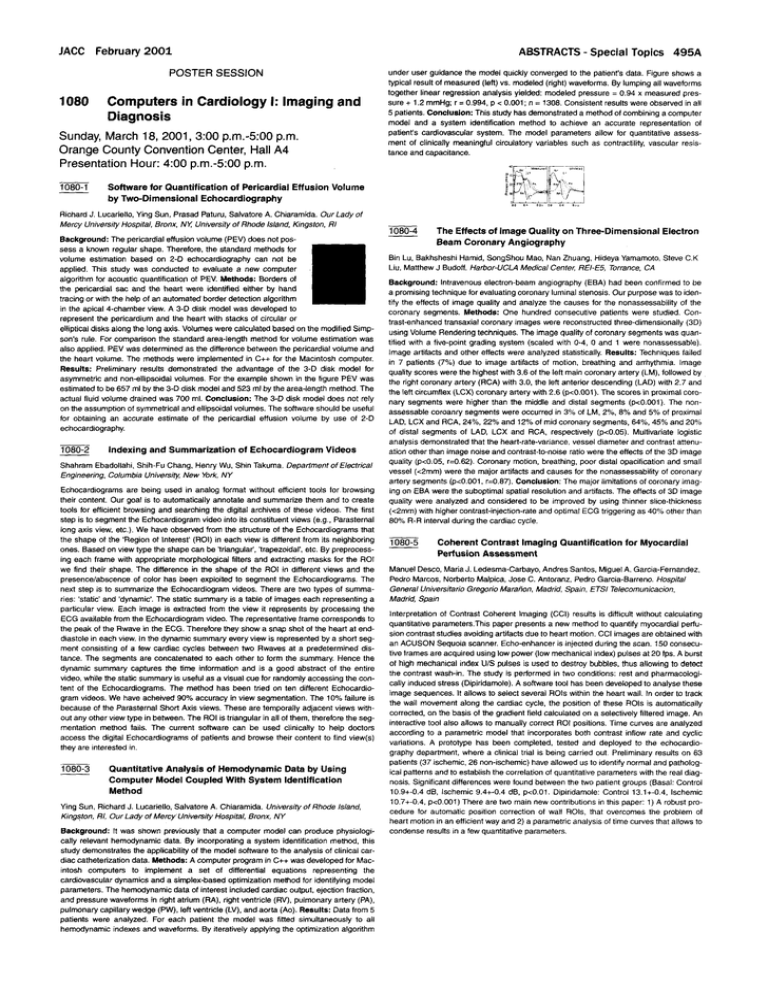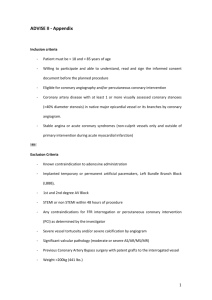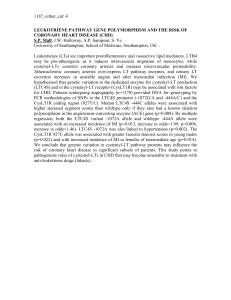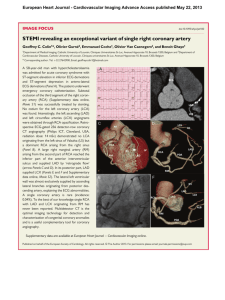1080 Computers in Cardiology I: Imaging ... Diagnosis Sunday, March 18, 2001, 3:00 p.rn.-5:00 ...
advertisement

ABSTRACTS - Special Topics 495A
JACC February 2001
POSTER SESSION
1080
Computers in Cardiology I: Imaging and
Diagnosis
Sunday, March 18, 2001, 3:00 p.rn.-5:00 p.m.
Orange County Convention Center, Hall A4
Presentation Hour: 4:00 p.m.-5:00 p.m.
1080-1
under user guidance the model quickly converged to the patient's data. Figure shows a
typical result of measured (left) vs. modeled (right) waveforms. By lumping all waveforms
together linear regression analysis yielded: modeled pressure = 0.94 x measured pressure + 1.2 mmHg; r = 0.994, p < 0.001 ; n = 1308. Consistent results were observed in all
5 patients. Conclusion: This study has demonstrated a method of combining a computer
model and a system identification method to achieve an accurate representation of
patient's cardiovascular system. The model parameters allow for quantitative assessment of clinically meaningful circulatory variables such as contractility, vascular resistance and capacitance.
Software for Quantification of Pericardial Effusion Volume
by Two-Dimensional Echocardiography
Richard J, Lucarie/Io, Ying Sun, Prased Paturu, Sclvatore A. Chiaramida. Our Lady of
Mercy University Hospital, Bronx, NY, University of Rhode Island, Kingston, FII
Background:The pericardial effusion volume (PEV) does not pos-
//
sess a known regular shape. Therefore, the standard methods for
volume estimation based on 2-D echooardiography can not be
applied. This study was conducted to evaluate a new computer
algorithm for acoustic quantification of PEV. Methods: Borders of
the pericardial sac and the heart were identified either by hand
tracing or with the help of an automated border detection algorithm
in the apical 4-chamber view. A 3-D disk model was developed to
represent the pericardium and the heart with stacks of circular or
eltipficai disks along the long axis. Volumes were calculated based on the modified Simpson's rule. For comparison the standard area-length method for volume estimation was
also applied. PEV was determined as the difference between the pericardial volume and
the heart volume. The methods were implemented in C++ for the Macintosh computer.
Results: Preliminary results demonstrated the advantage of the 3-D disk model for
asymmetric and non-ellipsctdai volumes. For the example shown in the figure PEV was
estimated to be 657 ml by the 3-D disk model and 523 ml by the area-length method. The
actual fluid volume drained was 700 ml. Conclusion: The 3-D disk model does not rely
on the assumption of symmetrical and ellipsoidal volumes. The software should be useful
for obtaining an accurate estimate of the pericardial effusion volume by use of 2-D
echocardiography.
1080-2
Indexing and Summarization of Echocardiogram Videos
Shahram Ebadollahi, Shih-Fu Chang, Henry Wu, Shin Takuma. Department of Electrical
Engineering, Columbia Universi~ New York, NY
Echocardiograms are being used in analog format without efficient toots for browsing
their content. Our goal is to automatically annotate and summarize them and to create
tools for efficient browsing and searching the digital archives of these videos. The first
step is to segment the Echocardiogram video into its constituent views (e.g., Parasternal
long axis view, etc.). We have observed from the structure of the Echocardiograms that
the shape of the 'Region of Interest' (ROI) in each view is different from its neighboring
ones. Based on view type the shape can be 'triangular', 'trapezoidal', etc. By preprocessing each frame with appropriate morphological filters and extracting masks for the ROI
we find their shape. The difference in the shape of the ROI in different views and the
presence/abscence of color has been exploited to segment the Echocardiograms. The
next step is to summarize the Echocardiogram videos. There are two types of summaries: 'static' and 'dynamic'. The static summary is a table of images each representing a
particular view. Each image is extracted from the view it represents by processing the
ECG available from the Echocardiogram video. The representative frame corresponds to
the peak of the Rwave in the ECG. Therefore they show a snap shot of the heart at enddiastole in each view. in the dynamic summary every view is represented by a short segment consisting of a few cardiac cycles between two Rwaves at a predetermined distance. The segments are concatenated to each other to form the summary. Hence the
dynamic summary captures the time information and is a good abstract of the entire
video, while the static summary is useful as a visual cue for randomly accessing the content of the Echocardiograms. The method has been tried on ten different Echooardiogram videos. We have acheived 90% accuracy in view segmentation. The 10% failure is
because of the Parasternal Short Axis views. These are temporally adiacent views without any other view type in between. The ROI is triangular in all of them, therefore the segmentation method fails. The current software can be used clinically to help doctors
access the digital Echocardiograms of patients and browse their content to find view(s)
they are interested in.
1080-3
Quantitative Analysis of Hemodynamic Data by Using
Computer Model Coupled With System Identification
Method
Ying Sun, Richard J. Lucariello, Salvatore A. Chiaramida. University of Rhode/s/and,
Kingston, RL Our Lady of MercyUniversity Hospital, Bronx, NY
Background: It was shown previously that a computer model can produce physiologically relevant hemodynamic data. By incorporating a system identification method, this
study demonstrates the applicability of the model software to the analysis of clinical cardiac catheterization data. Methods: A computer program in C++ was developed for Macintosh computers to implement a set of differential equations representing the
cardiovascular dynamics and a simplex-based optimization method for identifying model
parameters. The hemodynamic data of interest included cardiac output, ejection fraction,
and pressure waveforms in right atrium (RA), dght ventricle (RV), pulmonary artery (PA),
pulmonary capillary wedge (PW), left ventricle (LV), and aorta (Ao). Results: Data from 5
patients were analyzed, For each patient the model was fitted simultaneously to all
hemodynamic indexes and waveforms. By iteratively applying the optimization algorithm
1080-4
The Effects of Image Quality on Three-Dimensional Electron
Beam Coronary Angiography
Bin Lu, Bakhsheshi Hamid, SongShou Mac, Nan Zhuang, Hideya Yamamoto, Steve C.K
Liu, Matthew J Budoff. Harbor-UCLA Medical Center, REI-E5, Torrance, CA
Background:Intravenous electron-beam angiography (EBA) had been confirmed to be
a promising technique for evaluating coronary luminal stenosis. Our purpose was to identify the effects of image quality and analyze the causes for the nonassessability of the
coronary segments. Methods: One hundred consecutive patients were studied. Contrast-enhanced transaxial coronary images were reconstructed three-dimensionally (3D)
using Volume Rendering techniques. The image quality of coronary segments was quanfified with a five-point grading system (scaled with 0-4, 0 and 1 were nenassessable).
Image artifacts and other effects were analyzed statistically. Results: Techniques failed
in 7 patients (7%) due to image artifacts of motion, breathing and arrhythmia. Image
quality scores were the highest with 3.6 of the left main coronary artery (LM), followed by
the right coronary artery (RCA) with 3.0, the left anterior descending (LAD) with 2.7 and
the leff circumflex (LCX) coronary artery with 2.6 (p<O.001). The scores in prox{ma~coronary segments were higher than the middle and distal segments (p<0.001). The nonassessable coroanry segments were occurred in 3% of LM, 2%, 8% and 5% of proximaJ
LAD, LCX and RCA, 24%, 22% and 12% of mid coronary segments, 64%, 45% and 20%
of distal segments of LAD, LCX and RCA, respectively (p<0.05). Multivariate logistic
analysis demonstrated that the heart-rate-variance, vessel diameter and contrast attenuation other than image noise and contrast-to-noise ratio were the effects of the 3D image
quality (p<0.05, r=0.62). Coronary motion, breathing, poor distal opacification and small
vessel (<2mm) were the major artifacts and causes for the nonassessability of coronary
artery segments (p<0.001, r=0.87). Conclusion: The major limitafions of coronary imaging on EBA were the suboptimal spatial resolution and artifacts. The effects of 3D image
quality were analyzed and considered to be improved by using thinner slice-thickness
(<2mm) with higher contrast-injection-rate and optimal ECG triggering as 40% other than
80% R-R interval during the cardiac cycle.
1080-5
Coherent Contrast Imaging Quantification for Myocardial
Perfusion Assessment
Manuel Desco, Maria J. Ledesma-Carbayo, Andres Santos, Miguel A. Garcia-Fernandez,
Pedro Marcos, Norberto Malpica, Jose C. Antoranz, Pedro Garcia-Barreoo. Hospital
General Universitario Gregorio Mara#on, Madrid, Spain, ETSI Telecomunicacion,
Madrid, Spain
Interpretation of Contrast Coherent Imaging (CCI) results is difficult without calculating
quantitative parameters.This paper presents a new method to quantify myocardial perfusion contrast studies avoiding artifacts due to heart motion. CCI images are obtained with
an ACUSON Sequoia scanner. Echo-enhancer is injected during the scan. f50 consecutive frames are acquired using low power (low mechanical index) pulses at 20 fps. A burst
of high mechanical index U/S pulses is used to destroy bubbles, thus allowing to detect
the contrast wash-in. The study is performed in two conditions: rest and pharmacologically induced stress (Dipiridamole). A software tool has been developed to analyse these
image sequences. It allows to select several ROIs within the heart wall. ~n order to track
the wall movement along the cardiac cycle, the position of these ROIs is automatically
corrected, on the basis of the gradient field calculated on a selectively filtered image. An
interactive tool also allows to manually correct ROt positions. Time curves are analyzed
according to a parametric model that incorporates both contrast inflow rate and cyclic
variations. A prototype has been completed, tested and deployed to the echocardiography department, where a clinical trial is being carried out. Preliminary results on 63
patients (37 ischemic, 26 non-ischemic) have allowed us to identify normal and pathological patterns and to establish the correlation of quantitative parameters with the real diagnosis. Significant differences were found between the two patient groups (Basal: Control
10.9+-0.4 dB, Ischemic 9.4+-0.4 dB, p<0.01. Dipiridamole: Control 13.1+-0.4, Ischemic
10.7+-0.4, p<0.001) There are two main new contributions in this paper: 1) A robust procedure for automatic position correction of wall ROIs, that overcomes the problem of
heart motion in an efficient way and 2) a parametric analysis of time curves that allows to
condense results in a few quantitative parameters.








